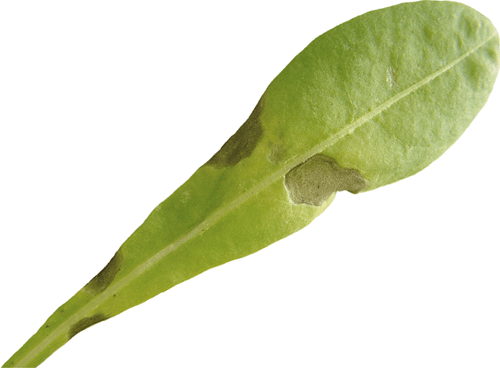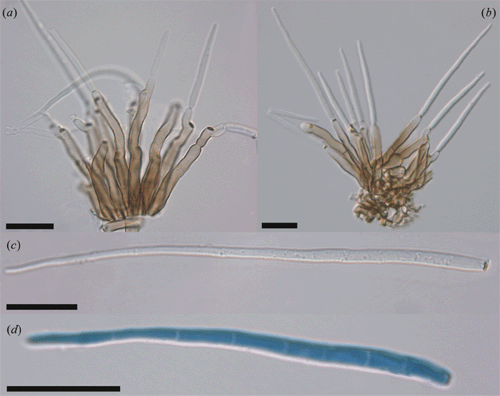Cercosporoid fungi on statice (Limonium sinuatum) in Australia
A. R. McTaggart A and J. R. Liberato B CA Faculty of Biological & Chemical Sciences, School of Integrative Biology, University of Queensland, Qld, Australia.
B Department of Primary Industries and Fisheries, Plant Pathology Herbarium, 80 Meiers Road, Indooroopilly, Qld 4068, Australia.
C Corresponding author. Email: jose.liberato@dpi.qld.gov.au
Australasian Plant Disease Notes 1(1) 37-39 https://doi.org/10.1071/DN06016
Submitted: 11 October 2006 Accepted: 20 October 2006 Published: 25 October 2006
Abstract
All fourteen dried specimens of cercosporoid fungi on Limonium held in Australian herbaria have been re-examined. Only Cercospora apii s. lat. was found, which is described and illustrated. C. insulana is considered an exotic pathogen for Australia.
Limonium sinuatum (L.) P. Mill. (statice, perennial sea lavender) is a perennial herb native to the Mediterranean and Asia Minor. It is cultivated worldwide for its brightly coloured, flat flower clusters that are used in dried and fresh flower arrangements.
Recently Crous and Braun (2003) concluded that there are only two cercosporoid fungi that infect Limonium (Plumbaginaceae), namely Cercospora apii s. lat. (= C. statices Pesante) and C. insulana Sacc. (= C. statices Lobik) and that these two species have been confused by many authors. As statice is an export commodity (Australian Trade Commission 2006), it is important to know which fungal species occur in Australia.
A search for Australian cercosporoid fungi on Limonium in the Australian Plant Pest Database (http://www.planthealthaustralia.com.au/APPD, verified 9 October 2006) and the herbarium BRIP database found 14 specimens. All of them were re-examined. BRIP 8438, BRIP 4597 and DAR 3989 were in poor condition and it was not possible to identify them. The others were identified as C. apii s. lat. A description of this pathogen is given below. Morphology of the fungus was examined on microscopic mounts in lactic acid. Observations and illustrations were prepared under a Leica DMLB microscope equipped with a Leica DC500 camera.
Cercospora apii Fresen. emend. Crous & U. Braun, Mycosphaerella and its anamorphs: 1. Names published in Cercospora and Passalora: 35 (2003), on Limonium sp. and L. sinuatum (Figs 1 and 2)

|

|
Leaf spots, mostly rounded, up to 7 mm in diameter, brown, sunken. Mycelium internal. Fruiting amphigenous. Stromata absent or 20–80 µm in diam, dark brown. Conidiophores solitary or in fascicles of 2–29, arising from internal hyphae or mostly from stromata, erect, basal part cylindrical and upper fertile part 0–3 geniculate, unbranched, 40–125 × 3–6 µm, 0–3(–4) septate, pale olivaceous to medium brown, smooth, thin-walled. Conidiogenous cells integrated, terminal and intercalary, sometimes only terminal, 12.5–75 μm long, multilocal (polyblastic) or unilocal (monoblastic), sympodial, conidiogenous loci conspicuous, situated at small shoulders caused by sympodial proliferation of the conidiogenous cells, or at the apices of the terminal conidiogenous cells, loci subcircular, thickened and darkened, ~3 μm wide. Conidia solitary, long conidia acicular, short conidia obclavate-cylindrical to cylindrical, 60–175 × 2.5–4 µm, up to 300 µm long when fresh specimens were moist incubated overnight, 0–18 septate, hyaline, smooth, thin-walled, base truncate, not attenuated, thickened and darkened. Distribution in Queensland and NSW, Australia.
Limonium sinuatum (L.) Mill.: Qld: Brisbane, 29 Nov. 1982, J.L. Alcorn (BRIP 13870); Brisbane, Sept. 1953, R.F.N. Langdon (BRIP 4598); NSW: Richmond, 28 May 1942, E.T. Edwards (DAR 3988); Mount Pritchard, 12 May 1941, L. Fraser (DAR 3991); Wyong, May 1947, coll. unknown (DAR 3990); Mullumbimby, 26 June 1984, K. Arthur (DAR 49918).
Limonium sp.: Qld: Helidon, 24 Apr. 1997, K. Spierling (BRIP 24437); 24 Aug. 2005, P.M. Stephens (BRIP 46840); Park Ridge, Brisbane, 20 Mar. 2006, L.I. Forsberg (BRIP 47218). NSW: Kellyville, 13 Mar. 1986, G. Murdocca (DAR 55502); Tenterfield, 01 Mar. 1996, N. De Stefani (BRIP 23207).
Recently Crous and Braun (2003) emended the species Cercospora apii and it is now a compound species, referred to as C. apii s. lat. It infects hundreds of plant species, unlike other species of Cercospora that are mostly considered to be host specific. Chupp (1954) provided a mixed description for C. insulana incorporating features of the two species, C. insulana and C. apii s. lat. Both species on Limonium have often been confused by many authors and it is uncertain if all host species and distribution data cited are correct. Most collections on Limonium spp. belong to C. apii s. lat. (Braun et al. 2003; Crous and Braun 2003). C. insulana can be easily distinguished from C. apii s. lat. as C. insulana has wider, obclavate-subcylindrical conidia (30–120 × 4–6 µm, 3–12 septate, apex subobtuse, base obconically truncate) and shorter conidiophores (10–60 × 4–9 µm, 0–2(-3) septate, pale brown) (Saccardo 1931; Braun et al. 2003).
The lists of plant diseases in Australia (Simmonds 1966; Pitkethley 1970; Chambers 1982; Sampson and Walker 1982; Cook and Dube 1989; Shivas 1989) report only one occurrence of Cercospora sp. on Limonium. It probably refers to the specimen BRIP 4598 (Simmonds 1966). Currently C. insulana should be considered an exotic pathogen for Australia.
Acknowledgements
The authors express their thanks to Herbarium DAR for specimen loans, to Leif Forsberg (Department of Primary Industry & Fisheries) for courteously providing a picture and to Dr Roger Shivas (Herbarium BRIP) for helpful discussion.
Braun U,
Hill CF, Dick M
(2003
) New cercosporoid leaf spot diseases from New Zealand. Australasian Plant Pathology 32, 87–97.
| Crossref | GoogleScholarGoogle Scholar |

Shivas RG
(1989
) Fungal and bacterial diseases of plants in Western Australia. Journal of the Royal Society of Western Australia 72, 1–62.



